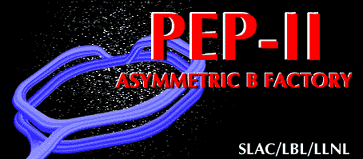
 |
The B-Factory gets its name because the collisions between positrons and electrons in the accelerator are designed to produce copious quantities of B-Meson subatomic particles. By studying these collisions and the decay of B-Mesons, physicists hope to understand Charge-Parity (CP) violation. CP violation is a subtle assymetry in the laws of physics at high energies like those present during the first flicker of time after the big bang. CP violation apparently is the reason why we have so much matter in our universe and comparitively little antimatter.
The lower ring in the B-Factory is called the High Energy Ring (HER) and circulates packets of electrons at 10-12 giga-electron-volts (GeV). The high energy ring is comprised mostly of refurbished dipole, quadrupole, and sextupole, magnets from the old PEP-I project. The HER does utilizes a new copper extrusion based vacuum system. Synchrotron radiation fans created when the particle beam trajectories are bent by the dipole (bend) magnets are captured in a distributed fashion along the extrusions which include cooling passages. A distributed pump removes gas generated along the length of these extrusions and uses the magnetic field generated by the long bend magnets to do so. SLAC and LLNL are designing, refurbishing, and fabricating the HER.
The upper ring in the B-Factory is called the Low Energy Ring (LER) and circulates packets of positron particles at 3.1-4.0 GeV. The LER is almost entirely newly built with the bulk of the dipole and quadrupole magnets being designed at LBNL and built by the Institute for High Energy Physics (IHEP) in China. Some other special magnets are being designed and built at LBNL and LLNL, while some others are being refurbished from PEP-I. The LER vacuum system utilizes aluminum extrusions with concentrated photon-stops to capture synchrotron radiation fans. A large pump sits directly below each photon stop capturing most of the gas generated by the incident synchrotron energy. The LER vacuum system is being designed and built at LBNL.
Since the two beams in the B-Factory are in seperate rings, there is a complicated section in the interaction region which brings the two beams together. The LER beam is steered out to the side of the HER, then down to a horizontal plane containing the HER. Finally the beams cross each other in the middle of a large detector dubbed BaBar. Since the two beams have different energies, there is assymetry in the collision which leaves the byproducts with some residual velocity roughly in the HER direction. This residual velocity increases the effectiveness of the detector scheme which ultimately provides the data for physicists to study.